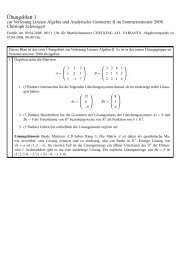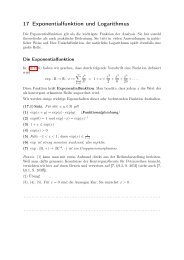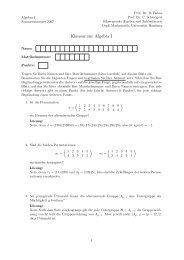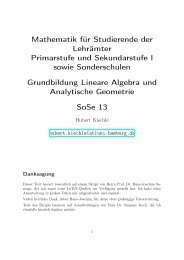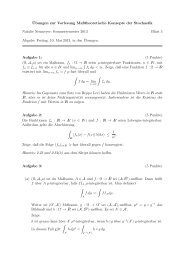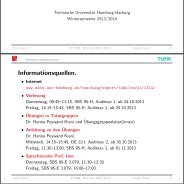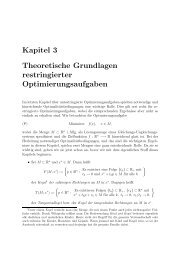pdf file
pdf file
pdf file
Create successful ePaper yourself
Turn your PDF publications into a flip-book with our unique Google optimized e-Paper software.
4.5 Yetter-Drinfeld modules<br />
We now present an important class of examples of braided categories. It will lead us to a class<br />
of factorizable Hopf algebras of particular importance. Using this class, we will also be able<br />
to show that any factorizable Hopf algebra is unimodular. This class of Hopf algebras will<br />
also be naturally realized in the Turaev-Viro construction of three-dimensional topological field<br />
theories.<br />
Some of the theory can be formulated for bialgebras. Whenever we deal with Hopf algebras,<br />
we will continue to assume that the antipode S is invertible (or that a skew antipode exists).<br />
Definition 4.5.1<br />
1. Let A be a bialgebra. A Yetter-Drinfeld module is a triple (V, ρ V , Δ V ) such that<br />
• (V, ρ V ) is a unital left A-module.<br />
• (V, Δ V ) is a counital left A-comodule:<br />
• The Yetter-Drinfeld condition<br />
holds for all h ∈ H.<br />
Δ V : V → H ⊗ V<br />
v ↦→ v (−1) ⊗ v (0)<br />
h (1) ∙ v (−1) ⊗ h (2) .v (0) = (h (1) .v) (−1) ∙ h (2) ⊗ (h (1) .v) (0)<br />
2. Morphisms of Yetter-Drinfeld modules are morphisms of left modules and left comodules.<br />
We write A AYD for the category of Yetter-Drinfeld modules over the bialgebra A.<br />
Example 4.5.2.<br />
Let us consider quite explicitly Yetter Drinfeld modules over the group algebra K[G] of a finite<br />
group G.<br />
Since we have the structure of a comodule, any Yetter-Drinfeld module has a natural structure<br />
of a G-graded vector space,<br />
V = ⊕ g∈G V g ,<br />
which is moreover endowed with a G-action. We evaluate the Yetter-Drinfeld condition for<br />
g ∈ H and v h ∈ V h . We find for the left hand side using Δ(g) = g ⊗ g and Δ V (v h ) = h ⊗ v h<br />
that gh ⊗ g.v h . For the right hand side, we find<br />
∑<br />
xg ⊗ (g.v) x .<br />
x∈G<br />
The equality of the two terms implies that only the term with x such that xg = gh contributes.<br />
Thus the Yetter-Drinfeld condition amounts to g.v h ∈ V ghg −1. Thus the G-action has to cover<br />
for the grading the action of G on itself by conjugation.<br />
We know that modules over a bialgebra form a tensor category, and so do comodules over<br />
a bialgebra. We can thus define as in proposition 2.4.7 and remark 2.4.8 on the tensor product<br />
of the vector spaces underlying two Yetter-Drinfeld modules V, W the structure of a module<br />
and of a comodule. We also note that the ground field with trivial action<br />
A ⊗ K → K<br />
a ⊗ λ ↦→ ɛ(a)λ<br />
106






